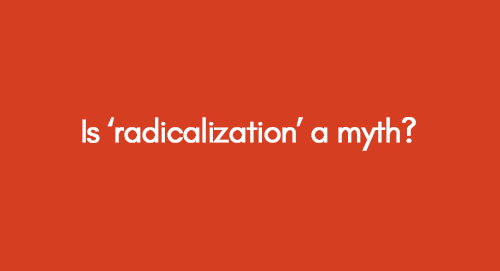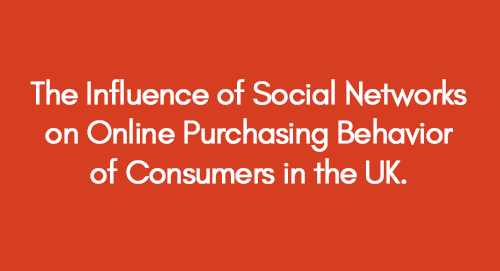
Brand Portfolio Strategies
July 6, 2022
Is ‘Radicalization’ a Myth? Learn in Detail
July 6, 2022As the pixels of social networks converge with the threads of consumer desires, a distinct tapestry of online purchasing behaviour unfolds in the UK, where digital whispers shape the choices echoing through the e-commerce corridors.
In the digital age, our online presence has become an integral part of our daily lives, transforming how we interact, gather information, and make purchasing decisions. Social networks, once primarily used to connect with friends and family, have evolved into powerful platforms that wield significant influence over our consumption habits. This blog embarks on a journey to delve into the profound impact social networks have on the online purchasing behaviour of consumers in the United Kingdom.
Learn More About Social Network
Explore More About Social Network
The United Kingdom, like much of the world, is deeply immersed in the digital landscape, with a substantial portion of its population active on social media. These platforms, such as Facebook, Instagram, Twitter, and Pinterest, have transcended their original purpose and now serve as thriving marketplaces where brands engage with potential customers. With over 48 million social media users in the UK as of 2021, comprising nearly 71% of the population, these networks play a pivotal role in shaping how consumers discover, research, and ultimately make online purchases.
Introduction
The rationale for choosing this research topic stems from the transformative impact of social networks on the dynamics of information sharing, both among individuals and businesses. This revolution in social networks has compelled business marketers to reevaluate the essential traits of businesses that facilitate meaningful engagement with their target consumers, particularly in a country like the United Kingdom. As Tsai (2017) has articulated, the evolution in communication technology has elevated social media to a platform that not only represents the voice of consumers but also offers valuable insights into their purchasing behaviour.
A series of distinct steps can characterize the core of online consumer behaviour in purchasing. These stages encompass assessing a product by gathering information from diverse social media sources, ultimately culminating in purchase decisions that are heavily influenced by the recommendations shared by fellow buyers regarding the product (Hudson et al., 2016).
Problem/Issue
The surge in popularity of social media networks has undeniably left its mark on the purchasing behaviours of consumers worldwide, including those in the United Kingdom (UK). Yet, one significant issue often overlooked by previous researchers pertains to the effective management of consumer purchasing behaviours within the diverse cultural landscape of the UK. This challenge has spurred the study to formulate research aims and objectives, which aim to address this gap in existing research and offer potential solutions for a more comprehensive understanding of this complex issue.
Objectives for the Research
Research invariably gives rise to multiple dimensions, generating fresh inquiries and considerations. It is imperative to establish a coherent set of research aims and objectives that will serve as the cornerstone of the study. For this current investigation, the following objectives have been articulated to facilitate a comprehensive examination and analysis of the topic:
To investigate the impact of social networks on consumer purchasing behaviour.
To scrutinize the role of social media as a determinant in the decision-making process for online purchases.
To pinpoint the shifts in online purchasing behaviour specific to the United Kingdom.
Literature Review
A literature review is a critical component of any research or academic work. It involves a systematic examination and analysis of existing scholarly sources, such as books, academic papers, and articles related to a particular topic or research question. Literature reviews provide a foundation for new research by summarizing, synthesizing, and critically evaluating the knowledge and findings in a given field, helping to identify gaps in the existing literature and informing the direction of future studies. They serve as a valuable tool for understanding the current state of knowledge and building on previous research to advance a particular study area.
Classification of Social Network
The emergence of social networks can be primarily traced back to the advent of Myspace in 2003 and Facebook in 2004. These two platforms swiftly gained immense popularity and were collectively coined "social media." According to Hudson (2016), the term 'Web 2.0' was initially coined to describe the Internet as a platform where content is not merely published but is continually enriched and modified by various users. This transformative approach to content modification involved participatory and collaborative methods, encompassing tools like wikis, blogging, and online articles, providing users with abundant information. Huang (2016) asserts that social networks have significantly broadened users' knowledge and access by facilitating the free flow of ideas and information, catering to diverse informational needs.
As per Young (2017), User-generated content (UGC) encompasses media content generated and shared publicly by end-users. However, Zabkar (2018) posits that such content should be created independently of professional practices, without any commercial motives or marketing agendas. Russell (2017) highlights that UGC is a commercial service involving voluntarily exchanging opinions and offers. When we consider the classification of Web 2.0 and UGC concepts, social networks can be defined as a suite of internet-based applications that underpin the principles of Web 2.0, enabling the creation and exchange of User-generated content (Robinson et al., 2017).
According to Gillani (2019), social networks can be categorized into various types, including collaborative endeavours (like Wikipedia and other websites), content networks (such as YouTube), person-to-person communication platforms (like Facebook), virtual gaming spaces (exemplified by World of Warcraft), and virtual social environments (as seen in Second Life). Furthermore, the realm of online business and professional reviews also extensively incorporates User-generated content (UGC), with platforms like Amazon and dpreview.com serving as prime examples.
As acknowledged by Nash (2019), social media platforms, including Facebook, Twitter, YouTube, and the more recent addition, Instagram, serve as online spaces where users establish individual accounts to communicate with others, access information, or share their content publicly. Tsai (2017) observes that the rapid growth in the accessibility and popularity of social media has made it an essential tool for utilizing the internet as a central instrument for business advancement and product sales. Additionally, according to Ramanathan (2017), social networks have the potential to revolutionize marketing strategies, as they enable companies to engage more effectively with users. In this way, social networking not only accelerates human communication but also exerts a significant influence on human behaviour.
Social Media as Word of Mouth
The concept of word of mouth (WOM) emerged in the 1950s and has experienced a revival in the age of the internet. According to Erkan (2018), WOM is "person-to-person communication between a receiver and a communicator whom the receiver perceives as non-commercial when discussing a brand, product, or service." WOM is a fundamental source of information for consumers, influencing their purchasing decisions and shaping their perceptions, attitudes, and expectations regarding brands, companies, and service providers, as highlighted by Shareef et al. (2019). Word of mouth plays a pivotal role across all phases of a consumer's decision-making process when purchasing a product or service. It assures the product's attributes and aids in assessing the selected service.
In our technologically advanced world, the power of word of mouth (WOM) has significantly surged in popularity, thanks to the heightened connectivity of individuals through social media. Dulabh (2018) elucidates that online or electronic word of mouth (eWOM) represents a variant of WOM, where users on social networking platforms offer feedback and evaluations on various products, brands, and services via review platforms. As described by Blank (2017), eWOM encompasses any positive or negative review shared by potential, current, or past customers about a product or company, made accessible to a vast audience and organizations through the internet. Electronic WOM can be disseminated through various channels, including social media platforms, comments, and recommendations on business-oriented online platforms. This information is seldom influenced by corporate marketing or communication. Vazquez (2018) contends that content generated by social network users, who are also consumers, is typically perceived as free from commercial bias. This trust in eWOM encourages consumers to turn to online shopping sites and other web-based platforms for their purchasing decisions (Lutz, 2017).
In the era of social media's transformative impact on shopping and consumer behaviour, electronic word of mouth (eWOM) has played an instrumental role in fostering awareness and recognition among a vast user base. This is particularly evident when users turn to sources that provide reviews and recommendations, as highlighted by Erkan and Evans (2018). As an illustration, practically every company, location, or restaurant listed on Google is accompanied by reviews and comments, readily accessible to users conducting searches. These reviews serve as crucial decision-making tools, enabling users to gauge the quality and reliability of a product or service through the insights and recommendations shared by other individuals, as emphasized by Shareef et al. (2019).
Variations in Purchase Behaviour
According to Fernando (2019), purchasing decisions and behaviour can be categorized into two main groups: those influenced by customers to a high or low degree and those involving brands that are either significant or less distinct. Complex purchasing scenarios, marked by high risk, demand substantial attention regarding data collection and evaluating product choices. This contrasts with dissonance-reducing behaviour, which also carries a high risk but is characterized by significant brand differences, requiring customers to undergo all phases of the decision-making process, as noted by Ryding (2018).
Blank and Lutz (2017) present various methods for evaluating consumer behaviour, each contingent on the research's objectives. One valuable approach is examining the decision-making process, which delves into the events that lead up to and follow a purchasing decision, shedding light on the decision-making process itself. As per Nash (2019), consumer decision-making can be defined as the collection of actions and characteristics displayed by a customer in the stages leading up to, determining, and ensuing the decision-making process for acquiring a product, service, or idea.
Ramadan (2018) acknowledges that the classical model remains a fundamental component of contemporary models for evaluating decision-making behaviour. While new models may omit certain elements, the five decision-making stages are still deemed relevant for assessment. These stages encompass problem recognition, information search, alternative evaluation, the actual purchase decision, and post-purchase behaviour, as outlined by Žabkar (2018).
Often referred to as the EKB or EBM model, this framework stands out as one of the most widely recognized and frequently employed standard models for examining consumer behaviour throughout the decision-making process. The core parameters for assessing behaviour predominantly revolve around the consumer's endeavours to acquire knowledge and comprehension of purchasing decisions and the considerations that stem from those decisions.
Hudson (2016) underscores the point that consumer behaviour is shaped not only by the impact of social networking platforms but also by the continuous marketing and advertising of a product through social and electronic media. The assessment criteria are crucial in determining how often a consumer engages with social media networks and the extent of their influence. A consumer's approach to social media and their decision to purchase through it is influenced by product variations, promotions, and pricing, all of which contribute to the consumer's ultimate decision, as elucidated by Fernando (2019).
Details of Your Research
For acquiring the desired information about research, mixed methods of data collection were used. This mixed method of data collection is supported by positivist research philosophy. Researchers have described positivism research philosophy as the research philosophy that uses an existing theory of research for developing the research hypotheses that are tested during the research processes. The researchers also described that positivist research uses the scientific approach for collecting and analysing the data for research.
With the use of a positivist research approach, the researchers can easily measure the strengths of the factors that are affecting research results. The scientific approach is based on establishing a dependent and independent variable of research. Such discrimination of the research variables helps the researchers determine the impact of one variable on the other variable of the study (Ryan, 2018). In the current research study, the influence of social media networks is an independent variable, whereas the dependent variable of research is the purchasing decisions of UK consumers.
The positivist research philosophy will help the current research deduce the result from the analysis part of the research. This deduction of research from a developed test is known as the deducing strategy of research that is supported by the use of positivist research philosophy (Ryan, 2018). In this manner, the research will successfully reach its end.
As the research is using mixed methods for data collection, the current research will be using primary and secondary data collection techniques that will help the researchers effectively reach their goals. The primary data collection technique will help the researchers collect the desired data for attaining the aim of this research through the help of survey questionnaires that will be based on the Likert scale approach. Using the Likert scale approach will help the researchers quantify the answers to the statements asked in the established questionnaire. This developed questionnaire will be distributed among the 100 consumers who have performed online shopping in the past three months. The developed questionnaire will be distributed among the households in the UK who use social media for making purchase decisions. A tool used for distributing and collecting questionnaires will be based on sending links to the developed questionnaire through Facebook Messenger.
Secondary data for this research will be based on previously developed research articles based on the search keywords of “buying behaviour of UK consumers”, “Impact of social media on consumers of UK”, and “Online buying behaviour of UK consumers”. The databases searched for the secondary articles will be Researchgate, Elsevier, Science Direct, and Jstor. These data databases of articles are reached online through their portal that supports the literature.
As the mixed method of data collection will provide both qualitative and quantitative data in the form of research articles and questionnaire results, respectively, the current research will be using two different methods of data analysis. Frist analytical test will be used on the qualitative data collected through research articles. The name of an analytical tool for the qualitative data of articles is content analysis. The content analysis helps the researchers analyse the available content from the secondary research articles and develop an understanding of the main findings of the articles that support the research questions.
The second analytical test for the quantitative primary acquired from the questionnaire will be statistical inferential tests performed with the famous statistical software SPSS. Descriptive statistics, correlation analysis, and regression analysis are the three main inferential statistical tests performed on collected quantitative data. The descriptive statistics explain basic inferential values of the collected data in terms of mean, standard deviation, and Kurtosis value. The correlation analysis will help the current research describe the association level among the research variables with the Pearson or Spearman correlation coefficient.
For defining the strength of the association among the research variables, regression analysis will be used. The regression analysis will explain the weak, moderate or strong association level among the research variables based on the values of ‘R’ described in the model summary table.
Research Ethics
As the current research involves the use of both primary and secondary data collection and analytical techniques, there are a vast amount of ethical considerations that must be acknowledged. It is explained by different researchers that whenever research is conducted on a given topic, it has to follow a certain ethics code that the court of law publishes for conducting ethical research. While conducting primary research, the main ethical concern is informed consent from the respondents. After obtaining informed consent, the researchers understand that the respondent answers the questionnaire willingly and intelligently. In this manner, it is assumed that the respondent is not coerced to provide his or her responses to the questions.
The second ethical concern that holds value in primary research is keeping confidentiality and respect for the information provided by the respondent by not sharing such information with other third parties. This also means that the researchers support the privacy of the respondents in every possible manner.
In collecting the secondary data for the research, the only ethical issue is data and plagiarism. That is, when the researchers use data from secondary sources, they must ensure that it is credible and that the words are not directly copied and pasted from the research information. Further, the secondary data must not be pirated.
Conclusions
From the developed research proposal, it can be concluded that social media usage has revolutionised the communication practices performed among market businesses and their consumers. The use of social media has brought changes in the purchasing patterns of consumers around the globe and in the UK. Still, the marketers of the business experience problems in identifying the purchasing behaviour of the consumers. The type of promotions that support the purchase decision of UK consumers on social media is based on the word-of-mouth marketing activities proposed by other peers who had performed online shopping.
Even though the word-of-mouth marketing practices of online social media users help develop the online purchasing behaviour of the consumers. Yet this type of behaviour tends to change among the culturally diversified consumers of the UK. Even though the researchers had described the change in the purchasing behaviour of online consumers as the change in the online support package that they are using for being connected online. Further, changes in the consumers' preferences are also subject to the deals and other offers that are provided on online social media.
Therefore, the current research uses mixed methods for collecting and analysing the collected data. The collected data will contain statistical analysis for effectively interpreting the collected results. In this manner, the research will reach its end.
Timetable for Your Research
Month | Dissertation Activity (parts) |
Month 1 | Developing and approving the research topic and proposal. |
Month 2 | Writing the first chapter. |
Month 3 | Collecting articles for developing a literature review. |
Month 4 | Writing the second chapter of the literature review. |
Month 5 | Developing a questionnaire and approving it. |
Month 6 | Writing the methodology chapter. |
Month 7 | Analysis of the results and development of the fourth chapter |
Month 8 | Writing the last chapter of concluding the research. |
Month 9 | Compiling the chapters and submitting the final work. |
References
Blank, G. & Lutz, C. (2017). Representativeness of social media in Great Britain: investigating Facebook, Linkedin, Twitter, Pinterest, Google+, and Instagram. American Behavioral Scientist, 61(7), pp.741-756.
Dulabh, M., Vazquez, D., Ryding, D. & Casson, A. (2018). Measuring consumer engagement in the brain to online interactive shopping environments. In Augmented Reality and Virtual Reality (pp. 145-165). Springer, Cham.
Erkan, I. & Evans, C. (2018). Social media or shopping websites? The influence of eWOM on consumers’ online purchase intentions. Journal of Marketing Communications, 24(6), pp.617-632.
Fernando, R.D. % Fernando, P.I.N. (2019). Impact of Social Media Marketing Activities on Consumer Buying Behavior for Casual Dining Restaurants in Sri Lanka.
Gillani, A., Kutaula, S., Leonidou, L.C. % Christodoulides, P. (2019). The impact of proximity on consumer fair trade engagement and purchasing behaviour: the moderating role of empathic concern and hypocrisy. Journal of Business Ethics, pp.1-21.
Hudson, S., Huang, L., Roth, M.S. & Madden, T.J. (2016). The influence of social media interactions on consumer-brand relationships: A three-country study of brand perceptions and marketing behaviours. International Journal of Research in Marketing, 33(1), pp.27-41.
Nash, J. (2019). Exploring how social media platforms influence fashion consumer decisions in the UK retail sector. Journal of Fashion Marketing and Management: An International Journal.
Ramadan, Z., Abosag, I. & Žabkar, V. (2018). All in the value: The impact of brand and social network relationships on the perceived value of customer-endorsed Facebook advertising. European Journal of Marketing, 52(7/8), pp.1704-1726.
Ramanathan, U., Subramanian, N., Yu, W. & Vijaygopal, R. (2017). Impact of customer loyalty and service operations on customer behaviour and firm performance: empirical evidence from UK retail sector. Production Planning & Control, 28(6-8), pp.478-488.
Shareef, M.A., Mukerji, B., Dwivedi, Y.K., Rana, N.P. & Islam, R. (2019). Social media marketing: Comparative effect of advertisement sources. Journal of Retailing and Consumer Services, 46, pp.58-69.
Tsai, W.H.S. and Men, L.R. (2017). Consumer engagement with brands on social network sites: A cross-cultural comparison of China and the USA. Journal of Marketing Communications, 23(1), pp.2-21.
Young, W., Russell, S.V., Robinson, C.A. & Barkemeyer, R. (2017). Can social media be a tool for reducing consumers’ food waste? A behaviour change experiment by a UK retailer. Resources, Conservation and Recycling, 117, pp.195-203.
Get 3+ Free Dissertation Topics within 24 hours?



























